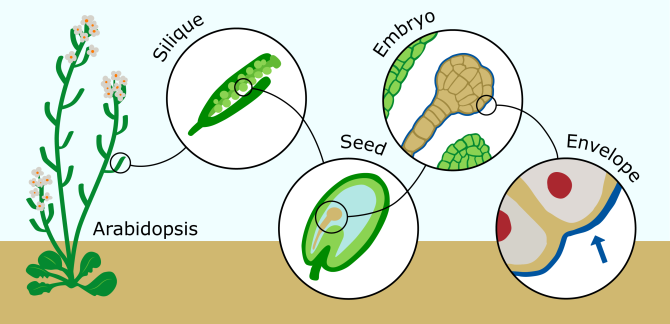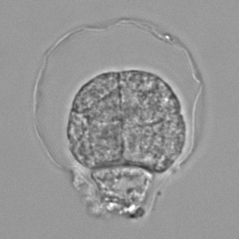
News
Scientists discover new component in world's best-studied plant
Wageningen researchers have discovered a previously unnoticed component within the thale cress: a thin film that encases the embryo in the seed. This discovery is particularly noteworthy because this species has been intensively studied for five decades. The newfound knowledge about the component could aid seed and breeding companies in maintaining the health of their seeds and plants.
Researchers from Dolf Weijers' biochemistry group and Joris Sprakel's mechanobiology group detailed their findings in the scientific journal Development. Although the exact role of this newly discovered component is not yet clear, scientists suspect that the embryonic envelope acts as a type of straitjacket, ensuring the embryo maintains the correct shape during its development.

During the initial days after fertilization, the nutrient layer surrounding the embryo is not fully developed, allowing for more space. The membrane may play a crucial role in ensuring the embryo maintains its proper shape, preventing uncontrolled growth and bulging of cells, according to Weijers and Sprakel.
Invisible force
Despite its possible role to hold the baby plant in shape, the embryonic envelope is incredibly thin, which explains why plant researchers overlooked it for decades. Discoverers Yosapol Harnvanichvech and Cecilia Borassi stumbled upon the film accidentally while attempting to separate the sixteen cells of a young plant embryo. An invisible force was holding the cells together. It was only when the researchers looked under a microscope to understand why the cells were not detaching that they saw the film surrounding the embryo.
“Then we knew what to look for,” says Borassi enthusiastically. The plant scientists scanned detailed images of plant embryos that colleagues had taken years ago with an electron microscope. “It is typically one of those components that you only notice when you know it is there.” When the Wageningen researchers looked at scientific publications, they discovered similar membranes in photos of embryos in tobacco plants. Weijers and Sprakel are convinced that the same component occurs in many more, if not all, plants.
Factor in seed production
The implications of this discovery are significant for seed and breeding companies, as the membrane is thought to play a crucial role in seed and embryo health.“If you do not know that such an embryonic membrane exists, you cannot take it into account,” says Weijers. A damaged, deformed, or even missing membrane could have severe consequences for the growth and development of the baby plant.
To understand the exact consequences, scientists must manipulate or remove the embryonic envelope in the lab, but this proves challenging as the envelope consists of fats and proteins that are attached to each other via cross-links. This makes it completely elastic, extremely strong and difficult to break down with chemicals. “We have tried endlessly, but we still haven't succeeded,” says Harnvanichvech.
Gatekeeper as an alternative hypothesis
If fellow researchers succeed, we will gain clarity about the exact function of the membrane and the consequences of any mishaps. While the researchers suspect the previously mentioned straitjacket function is the most obvious role of the envelope, they do not rule out other possibilities. The envelope could act as a gatekeeper allowing only a select group of chemicals to pass through. “This way it may protect the young, vulnerable embryos against harmful substances,” says Borassi. Finally, the embryonic envelope could serve as an attachment point for the protective fat layer that the plant later develops. The fat layer may adhere better to the membrane than to the embryo itself.

Although more research is needed to reveal the role of the embryonic membrane, Harnvanichvech and Borassi are excited about their discovery. “It's really cool to discover something new with fundamental science,” Borassi said.